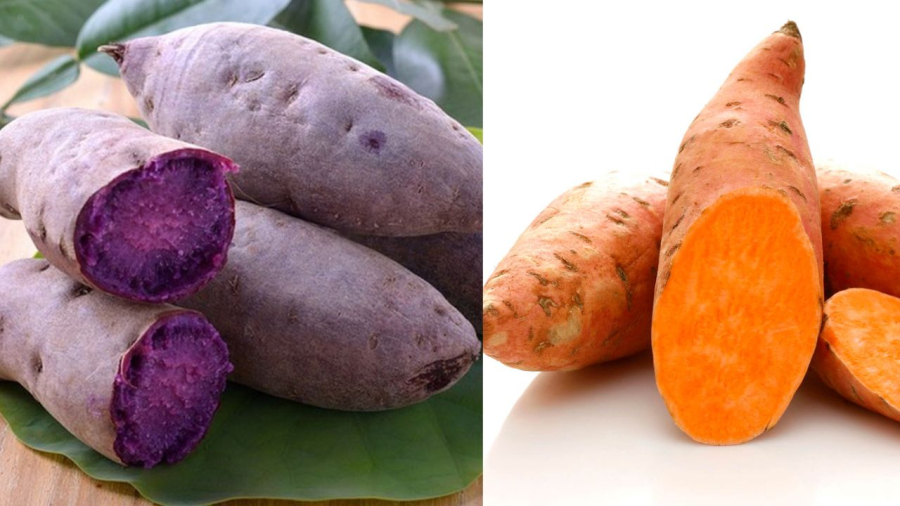Do different colored sweet potatoes have different nutritional values?
Sweet potatoes are a popular root crop that is increasingly favored for their nutritional benefits and are considered healthier than white rice. Sweet potatoes are rich in complex carbohydrates, which are slow-digesting carbs that do not cause sudden spikes in blood sugar levels after consumption. Sweet potatoes provide the necessary energy for normal cell function without the risk of obesity. According to the U.S. Department of Agriculture, a medium-sized ripe sweet potato provides 23.6g of carbohydrates (8% of daily requirements), 103 calories, and no fat or cholesterol.

Different-colored sweet potatoes have different flavors
Sweet potatoes also provide a significant amount of dietary fiber, which helps improve digestion, increase bowel movements, and prevent constipation. Sweet potatoes contain important nutrients such as vitamins A, B, C, potassium, manganese, magnesium, and copper, making them beneficial for preventing viral and bacterial infections…
An average sweet potato contains 30.8g of magnesium, which helps enhance nerve transmission and muscle contractions. It also has the ability to prevent and treat nervous disorders and anxiety.
Different colored sweet potatoes have similar nutritional values but differ in taste and nutrient content. However, the most basic difference lies in their antioxidant content, which contributes to the color of the sweet potato.
The difference between different colored sweet potatoes
Various types of sweet potatoes have different nutrient concentrations per unit weight, resulting in different flavors when consumed. Sweet potatoes with yellow or orange flesh are sweeter than those with white flesh.

Purple sweet potatoes are rich in anthocyanin antioxidants, while yellow sweet potatoes are rich in beta-carotene
One notable difference is their antioxidant content. Sweet potatoes with orange flesh are rich in carotenoids, while purple sweet potatoes are rich in anthocyanins. These antioxidants contribute to the different colors of sweet potatoes.
Carotenoids are yellow and orange pigments that serve as a source of vitamin A, enhance the immune system, and are beneficial for the eyes, preventing conditions such as Lou Gehrig’s disease. The most common carotenoids are beta-carotene, lutein, zeaxanthin, and lycopene.
Anthocyanins are natural flavonoids found in red, purple, and blue fruits. According to a study published in the Journal of Food and Nutrition Research, anthocyanins are not only potent antioxidants but also possess anti-inflammatory, antibacterial, and preventive effects against obesity, diabetes, cardiovascular diseases, and cancer.
Many people worldwide prefer purple-colored foods due to their high content of anthocyanin antioxidants. Studies comparing the antioxidant content of white, yellow, and purple sweet potatoes have shown that purple-fleshed sweet potatoes have the highest levels of antioxidants and soluble fiber.
Another study comparing sweet potatoes with white, yellow, and purple flesh confirmed these results. The conclusion published in the Journal of Preventive Nutrition and Food Science showed that all types of sweet potatoes have similar levels of polyphenols, but purple-fleshed sweet potatoes have the highest level of anthocyanin antioxidants, while white-fleshed sweet potatoes have the lowest level.
Therefore, when purchasing sweet potatoes, in addition to choosing based on personal preference for sweetness or mildness, you can refer to the information above to choose the variety that suits your needs: if you want to enhance antioxidant content, choose purple sweet potatoes; if you want to supplement vitamin A, choose sweet potatoes with yellow or orange flesh; if you prefer less sweetness, choose sweet potatoes with white flesh…
It is important to note that when consuming sweet potatoes, you should pay attention to gastric reactions, as some people may experience heartburn. It is recommended to consume a small amount of other foods before eating sweet potatoes.
How to Keep Eyes Healthy and Young-Looking: 7 Essential Tips
Do you want to protect the health and beauty of your eyes? Exposure to screens, smoke, and pollutants can cause early aging and contribute to eye-related diseases. Fortunately, there are a variety of ways to care for your eyes from the comfort of your home. Let’s explore some of these techniques in this article.



































